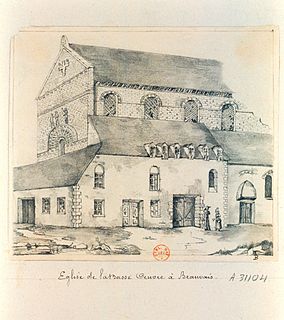The Capitulary of Servais was the implementation of an agreement between Charles the Bald and his half-brother Lothar to maintain the peace. In a conference of Charles and Lothar at Valenciennes in 853, the missi [literally, the sent ones] were re-established after a long hiatus. Lothar recommended that peace and justice be secured by sending out missi to enforce the laws and help keep the peace. The Diet of Servais confirmed the decisions arrived at during the conference. The Capitulary of Servais was enacted by Charles in November 853 dividing the Franco-Burgundian portion of Charles’ realm into twelve districts (missatica) to enforce the measures of this agreement. According to Nelson, the twelve missicati and associated missi were:

Charles the Bald was the King of West Francia (843–877), King of Italy (875–877) and Holy Roman Emperor. After a series of civil wars during the reign of his father, Louis the Pious, Charles succeeded by the Treaty of Verdun (843) in acquiring the western third of the Carolingian Empire. He was a grandson of Charlemagne and the youngest son of Louis the Pious by his second wife, Judith.

Lothair I or Lothar I was the Holy Roman Emperor, and the governor of Bavaria (815–817), King of Italy (818–855) and Middle Francia (840–855).
A missus dominicus, Latin for "envoy[s] of the lord [ruler]" or palace inspector, also known in Dutch as Zendgraaf, meaning "sent Graf", was an official commissioned by the Frankish king or Holy Roman Emperor to supervise the administration, mainly of justice, in parts of his dominions too remote for frequent personal visits. As such, the missus performed important intermediary functions between royal and local administrations. There are superficial points of comparison with the original Roman corrector, except that the missus was sent out on a regular basis. Four points made the missi effective as instruments of the centralized monarchy: the personal character of the missus, yearly change, isolation from local interests and the free choice of the king.
- Missaticum 1: Rheims, Voncq, Perthes, Bar-le-Duc, Chanzy, Vertus, Binson, Tardenois
- Missi: Bishop Hincmar [of Rheims], Ricuin, Engilscale
- Missaticum 2: Laon, Porcien, Soissons, Orxois, Valnis
- Missi: Bishop Pardulus [of Laon], Altmar, Theodacrus
- Missaticum 3: Noyon, Vermandois, Arras, Courtrai, Flanders, the counties of Engelram and the counties of Waltcaud
- Missi: Bishop Immo [of Noyon], Abbot Adalard [of St-Bertin], Waltcaud, Oldaric
- Missaticum 4: The counties of Berengar, Engiscalc, Gerard and the counties of Reginar
- Missi: Bishop Folcuin [of Thérouanne], Adalgar, Engiscalc and Berengar
- Missaticum 5: Paris, Meaux, Senlis, Vexin, Beauvais, Vendcuil
- Missi: Abbot Louis [of St-Denis], Bishop Erminfridus [of Beauvais], Ingilwin, Gotselm
- Missaticum 6: Rouen, Talau, Vimeu, Poitnieu, Amiens
- Missi: Bishop Paul [of Rouen], Bishop Hilmerad [of Amiens], Herloin, Hungar
- Missaticum 7: Avranches, Countances, Bayeux, Cotentin, Otlinga Saxonia and Harduin’s [part of that area], Eu, Lisieux
- Missi: Bishop Airard [of Lisieux], Abbot Theuderic [of Jumiéges], Herloin, Harduin
- Missaticum 8: Le Mans, Angers, Tours, Corbonnais, Sées
- Missi: Bishop Dodo [of Angers], Robert and Osbert
- Missaticum 9: Blois, Orléans, Vendôme, Chartres, Dreux, Chateaudun, Evreux, Arpajon, Poissy, Mardie
- Missi: Bishop Bouchard [of Chartres], Rudulf, Abbot Henry
- Missaticum 10: Troyes, Gatinais, Melun, Provins, Arcis-sur-Aube, Brienne
- Missi: Bishop Wenilo [of Sens], Odo [brother of Robert the Strong] and Donatus
- Missaticum 11: Counties of Milo and counties of Isembard, namely Autun, Macon, Chalon, [land of] Chattuarii, Tonnerre, Beaune, Deusme, the county of Attela, and the county of Romold
- Missi: Bishop Theutbald [of Langres], Bishop Jonas [of Autun], Abbot Abbo, and Daddo
- Missicatum 12: Nevers, Auxerre, Avallon
- Missi: Hugh, Gozso (or Cozso), Nibelung.
Hincmar, archbishop of Reims, was the friend, advisor and propagandist of Charles the Bald. He belonged to a noble family of northern Francia.
Ricwin , Count of Verdun.
Pardulus of Laon was bishop of Laon from 847 to 857. He is known for his participation in theological controversy. A letter of his to Hincmar of Reims is known.
See also Capitularies of Charles the Bald.





